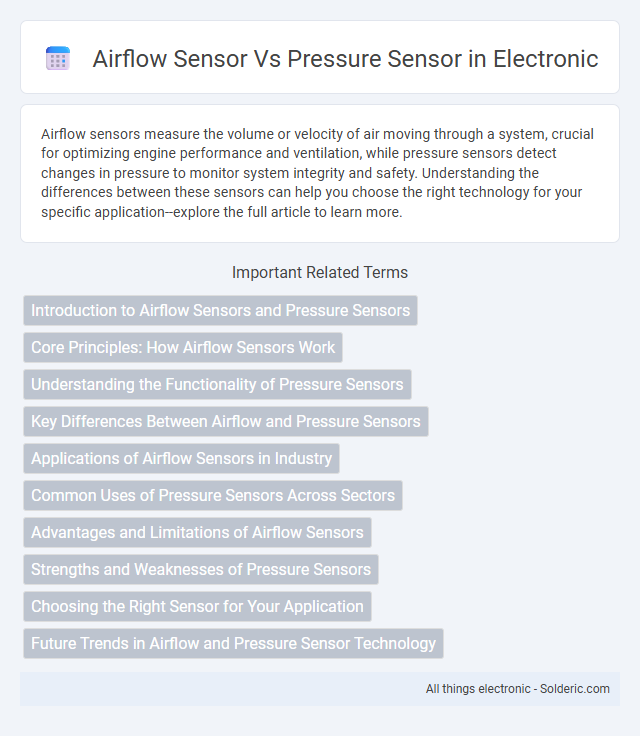Airflow sensors measure the volume or velocity of air moving through a system, crucial for optimizing engine performance and ventilation, while pressure sensors detect changes in pressure to monitor system integrity and safety. Understanding the differences between these sensors can help you choose the right technology for your specific application--explore the full article to learn more.
Comparison Table
| Feature | Airflow Sensor | Pressure Sensor |
|---|---|---|
| Function | Measures volume or velocity of air flow | Measures force exerted by air or fluid on a surface |
| Applications | HVAC systems, automotive engines, medical devices | Weather monitoring, industrial processes, fluid dynamics |
| Measurement Units | Cubic meters per second (m3/s), liters per minute (L/min) | Pascals (Pa), bar, psi |
| Sensing Principle | Thermal, vane, differential pressure | Piezoelectric, capacitive, strain gauge |
| Output | Analog or digital signal proportional to airflow | Analog or digital signal proportional to pressure |
| Typical Accuracy | +-1% to +-5% | +-0.1% to +-3% |
| Installation | Placed inline with air stream | Mounted on surfaces or within fluid lines |
| Cost | Moderate to high depending on technology | Low to moderate depending on sensor type |
Introduction to Airflow Sensors and Pressure Sensors
Airflow sensors measure the rate of air movement within a system, playing a crucial role in applications like HVAC, automotive engines, and medical devices. Pressure sensors detect the force exerted by gases or liquids on a surface, typically used for monitoring fluid dynamics, altitude, and industrial processes. Both sensors provide essential data for controlling environmental conditions, optimizing performance, and ensuring safety across various technologies.
Core Principles: How Airflow Sensors Work
Airflow sensors measure the velocity or volume of air moving through a system by detecting changes in thermal, mechanical, or ultrasonic properties caused by air movement. Core principles include thermal mass measurement, where heated elements cool at rates proportional to airflow, and differential pressure techniques that infer flow rates from pressure differences across a restriction. These sensors enable precise monitoring in HVAC, automotive engine management, and industrial automation applications, ensuring optimal performance and energy efficiency.
Understanding the Functionality of Pressure Sensors
Pressure sensors detect and measure the force exerted by gases or liquids on a surface, converting this physical pressure into an electrical signal for monitoring and control applications. Unlike airflow sensors, which specifically measure the velocity or volume of air movement, pressure sensors provide precise data on pressure levels critical for systems such as HVAC, automotive engines, and industrial machinery. Accurate pressure measurement ensures system safety, efficiency, and performance by enabling real-time adjustments based on pressure fluctuations.
Key Differences Between Airflow and Pressure Sensors
Airflow sensors measure the rate of air movement in a system, providing data on volume and velocity, while pressure sensors detect the force exerted by air or gas on a surface, indicating pressure levels. Airflow sensors are essential for applications requiring accurate air volume control, such as HVAC systems and automotive engines, whereas pressure sensors are crucial for monitoring and maintaining safe pressure ranges in pipelines and pneumatic systems. Understanding these key differences helps you select the appropriate sensor for precise measurement and control in your industrial or environmental application.
Applications of Airflow Sensors in Industry
Airflow sensors are crucial in industries such as HVAC systems for optimizing ventilation and maintaining air quality, automotive sectors for engine performance monitoring, and pharmaceutical manufacturing to ensure cleanroom conditions. These sensors provide real-time data on air velocity and flow rate, enabling efficient control of environmental conditions and process automation. Unlike pressure sensors that measure force per unit area, airflow sensors specifically monitor volumetric or mass flow, making them indispensable for applications requiring precise air movement analysis.
Common Uses of Pressure Sensors Across Sectors
Pressure sensors are extensively used in automotive systems to monitor tire pressure, engine performance, and fuel injection. In the healthcare sector, these sensors play a critical role in blood pressure monitors, respiratory devices, and infusion pumps. Industrial applications include hydraulic systems monitoring, leak detection, and process control, highlighting their versatility across sectors.
Advantages and Limitations of Airflow Sensors
Airflow sensors offer precise measurement of air volume and velocity, enabling accurate monitoring in HVAC systems and industrial processes. Their main advantages include non-intrusive design and rapid response times, which allow real-time air quality and ventilation control. However, airflow sensors can be affected by dust accumulation and require regular calibration, limiting their long-term reliability compared to pressure sensors.
Strengths and Weaknesses of Pressure Sensors
Pressure sensors excel in accurately measuring fluid or gas pressure within systems, offering robust performance in harsh environments and providing critical data for safety and control applications. However, they may face limitations such as sensitivity to temperature variations, potential drift over time, and susceptibility to mechanical damage in extreme conditions. Your choice between airflow and pressure sensors depends on application requirements, with pressure sensors being ideal for monitoring and controlling pressure-related processes but less effective for direct airflow measurement.
Choosing the Right Sensor for Your Application
Choosing the right sensor between an airflow sensor and a pressure sensor depends on the specific measurement requirements of your application, such as detecting volume flow rates or pressure changes within a system. Airflow sensors excel at measuring the velocity and volume of air or gases, making them ideal for HVAC systems, respiratory devices, and industrial ventilation monitoring. Pressure sensors are suited for applications requiring precise detection of gas or liquid pressure, including hydraulic systems, tire pressure monitoring, and barometric pressure measurement.
Future Trends in Airflow and Pressure Sensor Technology
Emerging developments in airflow and pressure sensor technology emphasize enhanced sensitivity, wireless connectivity, and integration with IoT ecosystems for real-time environmental monitoring. Advances in nanomaterials and MEMS (Micro-Electro-Mechanical Systems) are driving miniaturization and energy efficiency, enabling deployment in industrial automation, healthcare, and smart building applications. Future trends also highlight the adoption of AI algorithms for predictive maintenance and accuracy improvement in dynamic conditions.
airflow sensor vs pressure sensor Infographic

 solderic.com
solderic.com